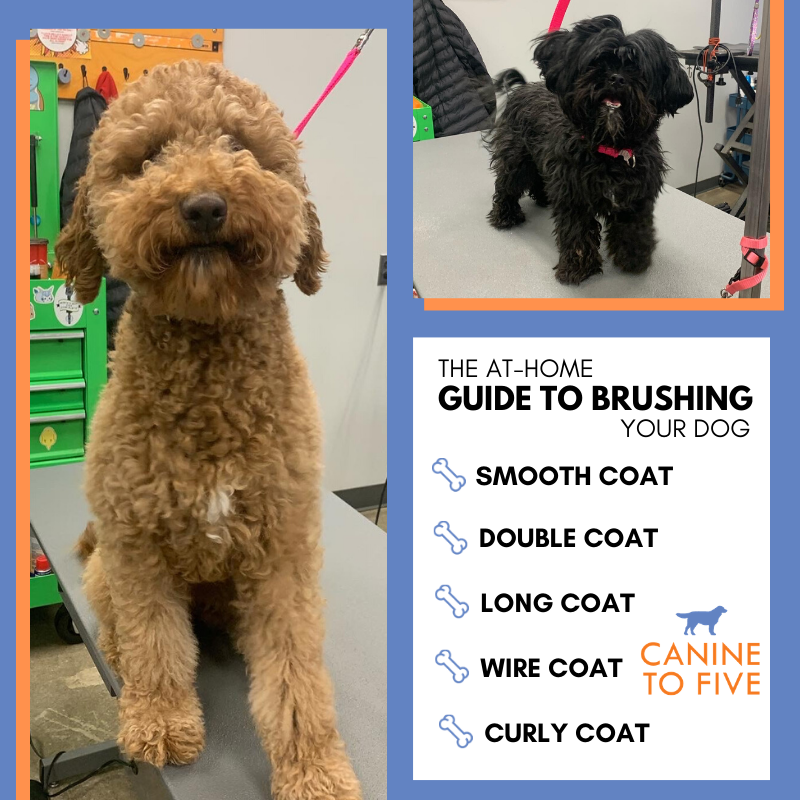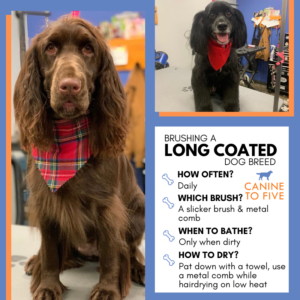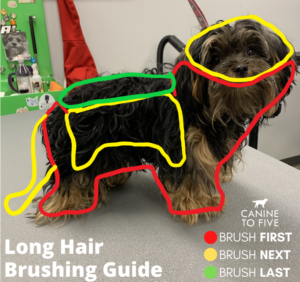The At-Home Guide to Brushing Your Dog

Brushing a dog’s coat properly is something that can stand in the way of a pet owner providing the best care for their four-legged friend. When adopting a dog, knowing how much coat maintenance will be required is just as important as knowing how much exercise they will need! There are 5 different coat types a dog can have: Smooth, Double, Long, Wire, or Curly. With the help from Canine to Five Detroit dog groomer, Brittany, we have compiled a valuable guide to brushing your dog’s coat at home.
Smooth Coat
The easiest coat type to maintain is the smooth coat. Dog breeds like Pit Bulls, French Bulldogs, Beagles, Boxers, and Greyhounds have this coat type that lays flat against their bodies. While they may be easy to maintain, brushing is still required! These breeds can still shed heavily and leave tiny hairs everywhere they go. It is best to brush weekly or more to remove loose hair, and to use a rubber brush. During shedding season, a Deshedding tool can be used to help remove excess hair.
Double Coat & Long Coat
A double coat is just that, two layers of fur. The top coat is made up of longer guard hairs that repel dirt and moisture, while the undercoat is dense to protect the dog from hot and cold temperatures. Breeds with a double coat can vary in length, with longer haired breeds like the Newfoundland, Old English Sheepdog, Shetland Sheepdog and Shih Tzu requiring a daily coat maintenance, and shorter haired breeds like the Labrador Retriever, Corgi, Australian Cattle Dog, and Smooth Collie requiring brushing every other day.
When brushing a double coat, it is best to begin brushing the undercoat first using a slicker brush. Longer double coats may require an undercoat rake to ensure the brush reaches the dog’s skin and can get through any tangles. For heavier tangles, an undercoat dematting comb can be used. Once brushed through, a metal comb can be used throughout the coat to ensure all tangles have been brushed through. Key areas to focus on are the ears, legs, tail, and areas where the collar/harness lays. During shedding season, a Deshedding tool can be used to help remove excess hair. Watch the video in our Curly Coat section for the best way to brush!
Groomer Brittany says, “The slicker brush is the best and should be used first. It shouldn’t take a lot of pressure to use. If it doesn’t slide through easily, use a detangler or combine conditioner and water to create your own. Always make sure there are no really right tangles or mating prior to bathing because it takes longer for them to dry afterwards and this can result in making the matting tighter and harder to remove. Use a metal comb that has wide and fine sides after using the slicker brush as your finishing tool.”
When it comes to shaving your dog’s double coat for the summer weather, or to simply avoid maintaining their coat, read this blog post to learn why it is not a good idea.
Wire Coat
Wire coated dog breeds, like Border Terriers, West Highland Terriers, and Irish Wolfhounds, can be easily brushed with the slicker brush first, then the metal comb to finish, on a weekly basis. An optional method used on wire coat breeds is called Hand Stripping. This is where a groomer will remove the dead hair from the top coat by the root to help the coat look more bright and vibrant.
Curly Coat
Curly coats can be difficult to maintain. These thick, soft curls grow close to the body and can easily become tangled and matted. Most pet owners do what’s called, “surface brushing” where they only brush the top coat and fail to get all the way to the dog’s skin. Here is a great video showing the proper way to brush your curly coated dog, and can also be used for double coated breeds as well.
Breeds like the Poodle, Bichon Frise, and any breed mixed with these like the Goldendoodle, Cavapoo, or Cavachon, will have a curly coat and should be brushed as shown in the video. When you encounter tangles or matting that isn’t too tight, you can follow the following video to work on dematting your dog’s hair. For tighter matting, trimming or shaving will be required.
Curly coated dogs must be brushed daily using a slicker brush to start, and a metal comb to finish. Key areas to focus on are the ears, legs, tail, and areas where the collar/harness lays.
Groomer Brittany says, “If you have to trim out matting, make sure it’s far enough away from the skin that you can separate the root of the hair with your fingers to block it from cutting the skin. Scissors lift as they cut, so anything closer than this requires a blade to remove because a blade can go under the mat. Never use crafting shears or kitchen shears. Always make sure you use hair cutting shears only.”
Recommended Products
- Artero Double Flexible Slicker
- Glendan Dog Brush & Cat Brush- Slicker
- Andis Pet Steel Comb
- 2 Sided Undercoat Rake for Cats & Dogs – Safe Dematting Comb
- Master Grooming Tools Ergonomic Undercoat Rakes
- Zoom Groom Rubber Wet Or Dry Brush
- Deshedding Grooming Tool
- BioSilk Therapy Detangling Best Detangling Spray
- Top Performance GloCoat Pet Conditioner and Detangler
- Nature’s Specialties Quicker Slicker Ready to Use Conditioner
Canine to Five offers full service dog grooming Mondays – Saturdays starting as early as 8AM.
Visit our Grooming Salon page to learn more!





